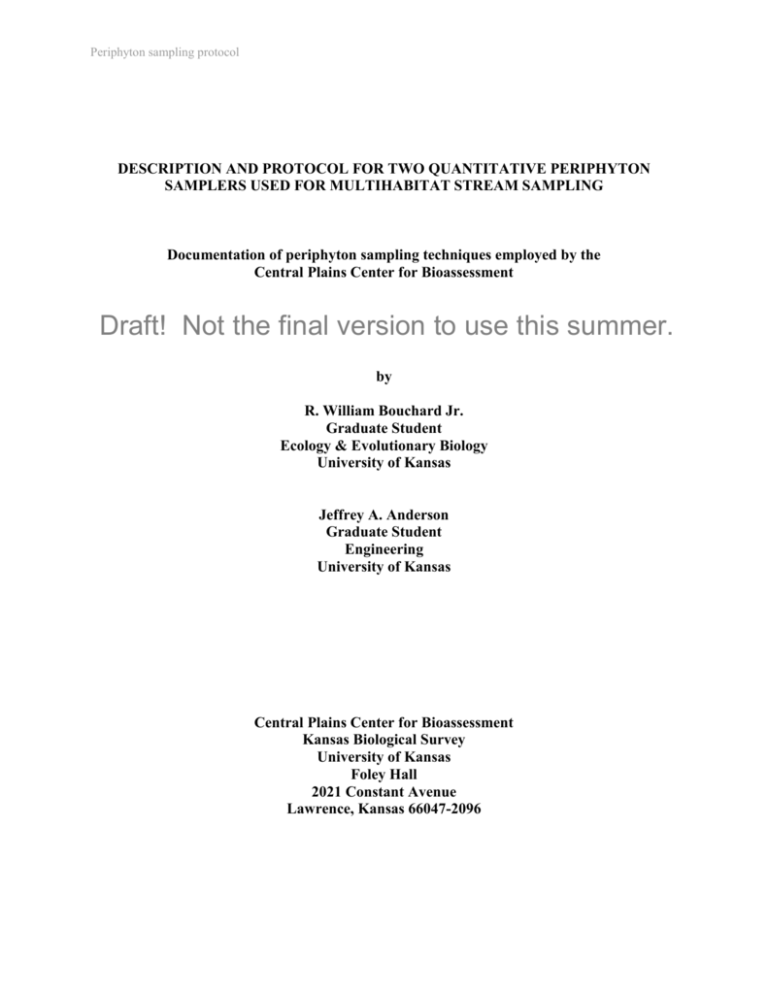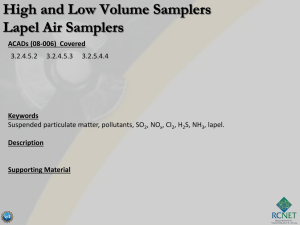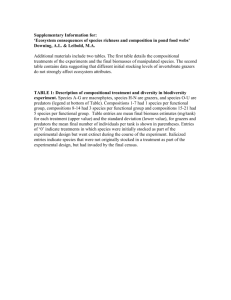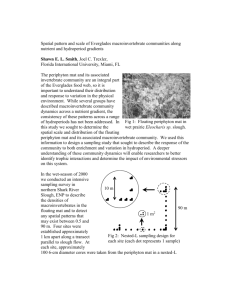Periphyton Protocol - Central Plains Center for BioAssessment
advertisement

Periphyton sampling protocol DESCRIPTION AND PROTOCOL FOR TWO QUANTITATIVE PERIPHYTON SAMPLERS USED FOR MULTIHABITAT STREAM SAMPLING Documentation of periphyton sampling techniques employed by the Central Plains Center for Bioassessment Draft! Not the final version to use this summer. by R. William Bouchard Jr. Graduate Student Ecology & Evolutionary Biology University of Kansas Jeffrey A. Anderson Graduate Student Engineering University of Kansas Central Plains Center for Bioassessment Kansas Biological Survey University of Kansas Foley Hall 2021 Constant Avenue Lawrence, Kansas 66047-2096 Periphyton sampling protocol The Central Plains Center for Bioassessment (CPCB) developed two quantitative periphyton samplers and associated protocols based on Barbour (1999), Gale (1975) and Bahls (1993) and employed them during the 2000 sampling season. Preliminary success indicate that these samplers and protocols provide a quick, easy and cost-effective method for sampling periphyton streams of the Central Plains region. The approach allows investigators to use a standard quantitative sampling method for periphyton when sampling streams with various Draft! Not the final version to use this summer. substrates that differ between and within streams. Periphyton consists primarily of attached algae, but can also include rotifers, protozoa, and bacteria attached to aquatic substrates along with free-living microorganisms found among the attached forms. For the purposes of the CPCB, we refer to periphyton as only the algal component of this community. As an intermediate between the chemical, physical and biotic factors in aquatic systems, periphyton is an important indicator of the health of aquatic systems (Lowe & Pan 1996). Periphyton is relatively stationary and most species have a short life cycle allowing periphyton communities to respond rapidly to perturbation (Rosen 1995). These organisms are a particularly useful indicator group for the CPCB due to their sensitivity to nonpoint source pollution. Periphyton sampling is also attractive for bioassessment as communities can colonize small areas, reducing the amount of destructive collecting needed for sufficient samples and reducing sampling effort. These tiny colonies can also support a species-rich algal community, with species representing a wide range of tolerance levels to a variety of pollution types (Rosen 1995). Their small size also eases transportation and storage of samples and reference specimens (Lowe & Pan 1996). The CPCB encounters five major periphyton colonization substrate types in freshwater streams of the Central Plains region: rock, silt, sand, woody debris and macrophytes. Many Periphyton sampling protocol 16-Feb-2016 periphyton sampling protocols call for a sampling of periphyton from cobble in riffles or runs, however, many of the streams sampled by the CPCB do not possess this type of habitat, making alternative periphyton colonization substrates more important in this region. In order to sample streams varying from cobbled streams to shifting sand streams, two different samplers were utilized to deal with the variance in periphyton habitat found in the Central Plains streams and rivers sampled by the CPCB. The first sampler (Figure 1) employs a bar clamp fitted with a soft rubber or foam collar similar to the device described by Gale (1975) and is best suited for Draft! Not the final version to use this summer. sampling periphyton colonizing cobble, woody debris and in some cases aquatic macrophytes. The second sampler is similar to the device described in Barbour (1999) and consists of a length of PVC pipe fitted with a soft rubber or foam collar (Figure 1). The PVC sampler is particularly useful in Central Plains streams, which are often dominated by runs or glides providing few solid surface areas for the colonization of periphyton. Both samplers use a collar with equal interior diameters thereby standardizing the sample area. A more original device utilized by the CPCB was an aspirator (Figure 1) used to collect the sample instead of a pipette or suction bulb as was suggested in Barbour (1999). The aspirator was employed as it provided more control when suctioning the sample from the substrate and it allowed the sample to be directly drawn into the sample vial. The CPCB decided against artificial sampling procedures, as it requires more sampling effort to set up the samplers and collect them on a subsequent trip (Bahls 1993). This is particularly important since the CPCB sampling sites are spread through at least four states making travel costs to retrieve the samplers significant. Another drawback of artificial substrates is the all too common destruction of samplers to vandalism and other causes resulting in the loss of data and money (Lowe & Pan 1996). The use of natural substrates should also provide a Page 2 of 13 Periphyton sampling protocol 16-Feb-2016 better representation of the actual periphyton communities and reduce bias resulting from an artificial substrate. Draft! Not the final version to use this summer. Figure 1: Original sampling devices used by the CPCB during the 2000 sampling season (from left to right; PVC sampler, bar clamp sampler & aspirator) The CPCB employed quantitative sampling from a constant area for a variety of reasons. Of greatest importance was that this type of quantitative sampling allows standardization of the sample area with a minimum of effort. Otherwise, entire rocks would have to be sampled and their surface area measured. This type of sampling would be further complicated by the fact that cobble substrate is often hard to find in the plains region of the central United States. Furthermore, quantitative sampling allows investigators to rigorously examine and assess various aspects of a stream’s primary production community and general stream health (e.g. effects of nutrient enrichment, ecotoxic responses, etc.) Page 3 of 13 Periphyton sampling protocol 16-Feb-2016 CONSTRUCTING THE SAMPLERS AND ASPIRATOR One of the major benefits of the CPCB samplers is they are simple devices that can be made from materials found in most hardware stores. The CPCB has made some modifications to the samplers and the aspirator using materials that were ordered from scientific supply stores and specialty stores, but most materials obtained at in hardware stores will suffice. Equipment for Periphyton Sampler Construction and Field Sampling Draft! Not the final version to use this summer. Clamp Sampler • Jorgensen® E-Z Hold II bar clamp and spreader clamp • soft waterproof rubber or foam collar (diameters?) • waterproof sealant PVC Sampler • length of PVC pipe (diameter?) • soft waterproof rubber or foam collar (diameters?) • waterproof sealant • (optional) rubber o-ring (fitting outside of PVC pipe) Aspirator • # 2 rubber stopper with two holes • aluminum tubing (7/32” diameter) • Nalgene 180 clear PVC tubing (I.D. 4.8mm; O.D. 6.4mm; Wall 0.8mm) • 40 mL clear vials (Environmental Sampling Supply - Type 1 Clear Glass Vial, open top/polypro with 0.125” septa) Others Material Needed for Field Sampling • stiff brushes • squeeze bottle with distilled water • label tape • sharpie pen • cooler with ice Page 4 of 13 Periphyton sampling protocol 16-Feb-2016 Construction of Sampling Devices Clamp Sampler The clamp sampler is relatively simple to construct although it requires the assistance of a metal shop. A hole matching the diameter of the area to be sampled is cut into the upper clamp plate. The rubber or foam collar is then attached to the underside of the upper plate with waterproof sealant. Draft! Not the final version to use this summer. PVC Sampler The PVC sampler is also a simple device to construct. The soft rubber or foam collar is simply attached to one end of the length of PVC piping with waterproof sealant. If the sampler is to used on hard substrates such as cobble or bedrock, the addition of a rubber o-ring glued to the outside of the pipe will provide better grip. Aspirator Two lengths of the aluminum tubing are cut (one ~ 4 cm and the other ~ 10 cm). The aluminum tubing is run through the holes in the # 2 rubber stopper (the holes may need to be enlarged) until ~ 1 cm is protruding from the top of the stopper. Two lengths of the soft tubing are cut (30 cm and 50 cm) and they are attached to the rigid tubing protruding from the top of the stopper. The longer tube is used as the aspirator mouthpiece to provide more time for the investigator to avoid contact with the sample should the sample vial overflow. Page 5 of 13 Periphyton sampling protocol 16-Feb-2016 FIELD SAMPLING TECHNIQUES Similar to other parameters sampled by the CPCB, periphyton is sampled during base flow events. Samples are collected from a proportion of substrates representing the dominant substrates in the sample reach as a representative of the most prevalent periphyton community present in the stream. The actual stream areas and selection of the substrates sampled is left to the discretion of the investigator(s). Although the CPCB employs a multihabitat technique, periphyton sampling in other regions could be performed using a single substrate (i.e. cobble, Draft! Not the final version to use this summer. sand or silt) or single habitat sampling (i.e. riffle, runs or depositional areas). During the 2000 field season, three periphyton samples were collected at each site, but this number may be increased to five to reduce measurement variance. Cobble, Woody Debris and Macrophyte Substrate Sampling At sample sites where unattached hard substrates are present (i.e. cobble and woody debris), the bar clamp sampler is recommended because it frees one of the investigator’s hands and it can create a better seal between the rubber or foam collar and the substrate. This sampler allows sampling of periphyton located in water deeper than 5 cm, provided the substrate can be reached and removed. The loss of loose periphyton from the substrate as it is removed from the stream is assumed to be minimal because much of this material is collected from relatively swift currents where the resident periphyton is well attached. The clamp sampler is also used to sample epiphytic algae from submerged macrophytes provide the plant has broad enough leaves to accommodate the sampling diameter. The CPCB has utilized Typha (cattail) and Sagittaria (arrowhead) leaves as well as some terrestrial plant material when sampling streams where these types of substrates were prevalent. Using these substrates generally required the placement of a Page 6 of 13 Periphyton sampling protocol 16-Feb-2016 back support in order to increase the thickness of the substrate to allowing clamping. The only other difference between the sampling of hard substrates and macrophytes is the periphyton must be brushed off more gently to avoid breaking the plant wall and collecting some of the substrate’s chlorophyll. 1. Before sampling, all vials are taped and labeled with the stream name, stream code, date and the investigator’s names Draft! Not the final version to use this summer. 2. Complete sampling of parameters that will be altered or compromised by entry into the stream or disturbance and disruption of substrate and associated materials (i.e. chemical and physical variables, habitat measures, etc.). 3. When cobble is common and can be located in the study stream, three rocks are selected randomly from the general population, but since the cobble must be relatively flat for sampling with the clamp sampler some cobble maybe rejected such that some selection may occur. Sample rocks should be free of filamentous algae at least in the area on the rock where the sample is to be taken. 4. With all of the sampling equipment in close reach (squeeze bottle, brushes, aspirator, sample vials) clamp the first rock on a flat area free of filamentous algae. With a two person collecting team, one individual can hold the clamp while the other collects periphyton from the rock. The use of the clamp sampler also allows a single investigator to sample with a little more difficulty. With only one investigator, once the periphyton substrate has been clamped, the clamp can be leaned against a support (i.e. large rock or log) or when possible, the bottom portion of the bar clamp can be pushed into the stream bank or bottom substrates. Page 7 of 13 Periphyton sampling protocol 16-Feb-2016 5. Using the stiff brush, loosen the periphyton within the well formed by the clamp and the rubber or foam collar and squeeze a small amount of DI water into the well. 6. Suction off the material in the well with the aspirator. 7. Brush the rock surface a second time, squeeze some water into the well and suction off the material again. Repeat a third time. 8. Rinse off the brush with a little DI water into the sample vial and cap the vial. 9. Unclamp the rock and return to the stream. Draft! Not the final version to use this summer. 10. Repeat the process with the second and third rocks with new vials. 11. Place the three periphyton samples in a labeled Ziplock bag and keep cold and dark in a cooler filled with ice (for up to two days) until lab processing. Soft Sediment Periphyton Sampling In many Central Plains streams, periphyton colonizing the surface of sand or mud can be located and sampled in shallow, calm stretches of the stream. The PVC sampler should be utilized in study sites where this habitat dominates or makes a significant contribution to the instream habitat. This sampler was primarily developed for use on soft substrates, but it can also be used for bedrock and cobble if the rubber or foam collar is soft enough to create a good seal between the rock and the collar. If using the PVC sampler for hard substrates, follow the sampling protocol for the clamp sampler. If a waterproof seal can be made, the only drawback of using the PVC sampler on hard substrates is it requires the use of an extra hand to secure the sampling device. When sampling from soft sediments, the same aspirator apparatus is used, but a squeeze bottle and brushes are not needed. This sampling method is also useful in sampling streams with Page 8 of 13 Periphyton sampling protocol 16-Feb-2016 sluggish flow and high sediment loads where periphyton is colonizing soft sediment covering cobble and other hard substrates. In this case, removing the rock or substrate for clamping causes the sediment and the periphyton covering the rock to slip off before it can be sampled. The PVC sampler allows a greater range of sampling substrates compared to the bar clamp sampler, but it can not sample periphyton deeper than ~10 cm (depending on the length of the PVC pipe) unless the substrate can be removed from the stream. Draft! Not the final version to use this summer. 1. Before sampling, all vials are taped and labeled with the stream name, stream code, date and investigator(s). 2. Complete sampling of parameters that will be altered or compromised by entry into the stream or disturbance and disruption of substrate and associated materials (i.e. chemical and physical variables, habitat measures, etc.). 3. Sample locations are selected by finding shallow, calm areas where periphyton is able to colonize the soft sediment without being dislodged. 4. Once a site is selected, the PVC sampler is gently placed over the sediment and held down with one hand. 5. With the other hand, the suction tube of the aspirator is used to suction the upper layer of the sediment into the sample vial. 6. Repeat in two other locations with the other two sample vials. 7. Place the three periphyton samples in a labeled Ziplock bag and keep cold and dark in a cooler filled with ice (for up to two days) until lab processing. Page 9 of 13 Periphyton sampling protocol 16-Feb-2016 IMPROVEMENTS & MODIFICATIONS There are some minor yet significant improvements that should be performed before future sampling. 1) The rubber collar originally used on the clamp sampler was too stiff, making it difficult to create a watertight seal between substrates with a fairly uneven surface and the collar. A waterproof neoprene, foam or softer rubber collar may correct this problem and increase the number of substrates that can be sampled. Changing the collar on the PVC sampler would also allow the use of the PVC sampler on all substrates including cobble, woody debris Draft! Not the final version to use this summer. and macrophytes thereby reducing the need for the clamp sampler. 2) In the future a more durable clamp should be used since the clamp we used (Jorgensen® E-Z Hold II bar clamp) tended to wear out after several field trips. This problem may have been due to the stiffness of the rubber collar on the bar clamp sampler, which required more pressure to create a watertight seal and placed additional strain on the apparatus. A softer collar should reduce pressure and strain on the clamp and prolong its use. 3) A softer, more flexible tubing could be used for the aspirator to make the suction tube easier to maneuver. 4) A filter or a safety chamber installed on the aspirator tube would help prevent the accidental contact or ingestion of the sample. We hope to have most of these improvements implemented before the next sampling season. CONCLUSION The periphyton samplers and techniques utilized by the CPCB have allowed periphyton sampling to be reduced to 5-10 minutes with a minimum of effort. These techniques are easily performed by a two-person field team, but can be utilized by a single individual if necessary. Analyses should be performed using existing CPCB data to determine the repeatability of these samplers and would give further indication of the accuracy of these protocols. Another potential Page 10 of 13 Periphyton sampling protocol 16-Feb-2016 source of sampling error that might be examined is the loss of deposited or loosely attached periphyton during sampling. For our purposes we assumed this loss was minimal, but Aloi (1990) states that loose periphyton contributes significantly to periphyton communities. Since some sampling is performed within the stream (i.e. sand, mud or bedrock) with the PVC sampler and other samples are taken outside of the stream (i.e. cobble, macrophytes and woody debris) with the bar clamp sampler, the loss of loose periphyton may be a cause of some error and sample site variance. In the future, recording information on the type of substrate, sampler used Draft! Not the final version to use this summer. and flow speed for each sample will be recommended in order to determine the error these variables may induce in the sampling and if the error is large enough to warrant further standardization. Although some minor improvements remain to be completed, the first season of implementing these samplers and the associated protocols indicated that they provide a rapid and cost-effective method of sampling periphyton quantitatively from a variety of streams and substrate types for bioassessment purposes. Page 11 of 13 Periphyton sampling protocol 16-Feb-2016 REFERENCES Aloi, J.E. 1990. A critical review of recent freshwater periphyton field methods. Canadian Journal of Fisheries and Aquatic Sciences. 47: 656-670. Bahls, L.L. 1993. Periphyton bioassessment methods for Montana streams. Montana Water Quality Bureau, Department of Health and Environmental Science, Water Quality Bureau, Helena, Montana. Barbour, M.T., J. Gettitsen, B.D. Snyder & J.B. Stribling. 1999. Rapid bioassessment protocols for use in streams and wadeable rivers: periphyton, benthic macroinvertebrates and fish, second edition. EPA 841-B-99-002. U.S. Environmental Protection Agency; Office of Water, Washington D.C. Draft! Not the final version to use this summer. Gale, W.F. 1975. Ultrasonic removal of epilithic algae in a bar clamp sampler. Journal of Phycology. 11: 472-473. Lowe, R.L. & Y. Pan. 1996. Benthic algal communities as biological monitors. In R.J. Stevenson, M.L. Bothwell & R.L. Lowe (eds). Algal Ecology: Freshwater Benthic Ecosystems. Academic Press. San Diego, CA. pp. 753. Rosen, B.H. 1995. Use of periphyton in the development of biocriteria. In: W.S. Davis & T.P. Simon (eds.) Biological Assessment and Criteria: Tools for Water Resource Planning and Decision Making. Lewis Publishers, Boca Raton, FL. pp. 415. Page 12 of 13









